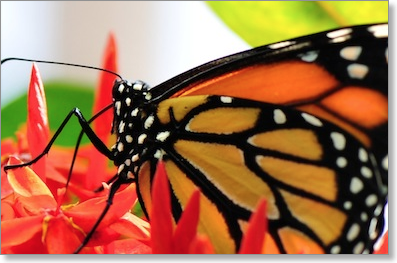866-295-4143, fbns@wayoflife.org

The monarch butterfly lives up to its name in that it is the king of these amazing creatures and a wonderful icon of divine creation. I own many books on butterflies and have visited prominent butterfly conservatories in several countries, and in my experience evolutionists don’t even try to explain how such a creature could have evolved. They merely presume that it did. They even talk about the “co-evolution” of the butterfly and the flower, as if natural selection and mutation or any other naturalistic concept could possibly explain the origin of such wonderful symbiotic relationships! How could blind evolution create such a thing? If the flower and the pollinating insect did evolve, they had to have evolved at exactly the same time--like in the same day or week--because they are dependent on one another for their very existence.
Metamorphosis
The monarch butterfly’s Latin name, Danaus plexippus, means “sleepy transformation,” referring to its amazing life cycle.
The butterfly goes through a four-stage process called metamorphosis: from egg, to larva, to pupa, to adult.
It begins life as a tiny, brilliantly-designed EGG that the female butterfly attaches to the exact type of vegetation needed by the caterpillar when it hatches. It is attached with a special glue that hardens rapidly and holds the egg securely in all types of weather. The egg stage usually lasts a few days, but eggs laid before winter can enter a resting stage and hatch the following spring.
Within this tiny egg is an entire world of genetic information. It contains the instructions for the construction of the caterpillar and to create the intelligence it needs to operate all of its organs (eyes, antennae, legs, etc.), to maneuver within its environment, to digest leaves, to avoid predators, to know when and how to molt, to pupate, etc. It contains the instructions for the incredibly complex process of the final molting and formation of the pupa, including the amazing cremaster mechanism. It contains the instructions for the death and dissolution of the caterpillar into a biological soup and the reformation of that soup into a beautiful butterfly. It contains the instructions not only to construct the butterfly in all of its mind-boggling complexity (e.g., its proboscis, its compound eyes, its intricately shingled wings, its sensory organs, its reproductive organs) but also to create the butterfly’s brain and the intelligence needed to thrive within its environment, to fly, to land, to avoid predators, to find the right plants and flowers, to drink and digest nectar, to keep its cold-blooded metabolism in balance, to reproduce. It contains the instructions for a bewildering multi-thousand mile migration to a place it has never been and in the absence of any earthly guide. It would seem, in fact, that the genetic code within that tiny monarch butterfly egg contains a map of a large part of the earth! And it contains the information for constructing hundreds of copies of itself.
The creature emerges from the egg as a larva or CATERPILLAR. It is an eating machine that increases its weight 3,000 times in 20 days, doubling in size about every 12 hours. This would be like a human baby increasing from eight pounds to 24,000 pounds in less than two weeks! The monarch caterpillar eats only milkweed, which is poisonous to other insects. It “sequesters” this substance and retains it through the metamorphosis process into the butterfly stage, thus providing protection for the flying insect.
The caterpillar has three pairs of “true legs” and up to six pairs of “prolegs.” The prolegs have rings of tiny hooks called crochets that help them grip the leaves and stems of plants. The creature’s brain and nervous system control the extremely complex coordinated movement of its legs. Some caterpillars can produce smelly chemicals that it uses for defense. The caterpillar weaves a mat of silk threads on the leaves on which it walks. “The silk is produced by a spinneret situated behind the mouth-parts, so the caterpillar has to move its head from side to side in order to weave the silk mat. ... This silk helps the caterpillar to hold on to the leaf. There is some evidence that the silk threads may also serve as a chemical trail to help the caterpillar trace back its path if it has a particular hideout” (Butterflies of Peninsular India).
As the caterpillar grows, it casts off its outer skin layer four or five times. This is called molting, and it is necessary to accommodate its rapidly increasing size.
“There are sensors in the skin of the caterpillar that are strain detectors, that detect the amount of pressure or strain being put on the skin and when that is too great they send a signal to the brain which then releases a hormone that causes molting” (Paul Nelson, Biola University, Metamorphosis, DVD, Illustra Media, 2011).
When the caterpillar molts, it sheds its entire head capsule, with its six eye lenses and spinneret. Thus, during the molting stage, “there must be four or five different head capsules made, each one being bigger to accommodate the growing caterpillar” (Jules Poirier, From Darkness to Light to Flight, p. 6).
Toward the end of the caterpillar stage, “imaginal cell clusters” appear at various locations in its body, and these contain the information for the future butterfly.
When it has grown to the right size, the caterpillar locates a suitable place on a milkweed leaf. It might make long journeys of 10 to 20 yards searching for the proper location. It spins a silk pad, from which it hangs by its prolegs to form a PUPA OR CHRYSALIS. After a day or two, the caterpillar molts the final time but this time the post molting appearance is completely different. “There is no longer any head capsule, no jaws and no legs. The new appearance is of a relaxed and wet pupa.”
During the final molt, the caterpillar attaches itself firmly to the silk pad by means of a CREMASTER that has microscopic hooks. This is an absolutely essential step, since it has been hanging by its prolegs but these will be shed with the final molting.
“When the skin is pushed to the top it uncovers a hole above the abdominal area, about 0.25 inches from the end of the pad. A black, stalk-like cremaster (about 0.1 inch long) protrudes through this hole. It lunges three times forward through the hole toward the silk pad. On the outer end of this cremaster is a bulb covered with hundreds of microscopic hooks of various forms. On the third lunge the front end pierces the silk pad, after which the body of the caterpillar rotates clockwise three times, thrusting the cremaster hooks deeper into the silk pad. In this position the body of the caterpillar begins to do all kinds of convulsive gyrations to remove the old outer skin from the silk pad. ... The insertion of the cremaster into the silk pad at the precise time is very critical to the survival of the butterfly ... [and] the insertion of the cremaster was accomplished by a totally blind caterpillar. Think of all the carefully coordinated design features of this transformation process” (Poirier, From Darkness to Light to Flight, pp. 10, 11).
The pupa must be attached securely to the silk pad. If the pupa falls at this point it ruptures, because it is full of liquid. The cremaster’s microscopic hooks attach something like Velcro but “the connection is so tight that if one simply pulls at the chrysalis, the chrysalis will break before the hooks pull lose from the silk pad. This protects the cremaster from being blown loose in storms” (Edith Smith, “Meandering Thoughts,” Aug. 21, 2010, Shady Oak Butterfly Farm, Brooker, Florida).
After a few hours the pupal skin hardens.
Butterfly pupae come in a wide variety of shapes and sizes. Some are cleverly camouflaged. The pupa of the tailed jay looks like a new bud, while that of the giant owl butterfly looks like a dead leaf.
During the pupa stage, the creature’s body and organs and even its very cells dissolve into a cellular liquid referred to as “SOUP.”
“Cell death is programmed. If you kill the wrong cells, you are in deep trouble. It’s very carefully engineered. You’re going to save some of the cell population so you have to know where you’re going to end up before you start” (Metamorphosis, DVD, Illustra Media, 2011).
This “soup” reorganizes itself into a beautiful butterfly!
Dr. David Stone observes:
“This is so far beyond the best of human technology, that words fail. Hire the brightest scientists and engineers on the planet, give them an unlimited budget, even unto trillions of dollars, and an open-ended schedule, and how likely is it that they could generate such a ‘soup’? Zero. This is yet another example that there is no theory of evolution, or even a wild speculation, to account for such an ubiquitous little creature as a butterfly.”
When it is ready to emerge, the butterfly taps onto the front of the pupa with its legs and the pupal skin breaks and opens in front like a door. The butterfly exits and suspends itself in order to pump the veins of its wings full of fluid to unfold them. This takes about 15 minutes. It also joins the two segments of its proboscis to form one sucking tube. It knows how to do all of this, though it has never existed in this form before.
The caterpillar has 16 short legs, a chewing mouth, six simple eyes that see only in black and white, eats leaves, and crawls. The butterfly has six long articulated legs, a sucking mouth, antennae, a proboscis, four wings, reproductive organs, two complicated compound eyes that can see in color, drinks nectar, and it can fly!
The change has been likened to a Model-T Ford forming its own garage and then within that garage disassembling itself and then reassembling itself into a high-tech helicopter and flying off. Even this would not be nearly as dramatic, though, as the real change that occurs through butterfly metamorphosis.
Metamorphosis is described even by secular biologists as a “miraculous change of form.” They admit that “there is no evidence how such a remarkable plan of life ever came about” (Peter Farb, The Insects, Life Nature Library, p. 56).
Science journalist Richard Milton says, “To say that this process is not understood ... means that no stage or aspect of this physical process can be accounted for or even guessed at with our current knowledge of chemistry, physics, genetics, or molecular biology, extensive though they are” (Shattering the Myths of Darwinism, p. 220).
Michael Pitman, who taught biology at Cambridge, asks how it would be possible for metamorphosis to have evolved:
“Within this dry shell the organs of the caterpillar are dissolved and reduced to pulp. Breathing tubes, muscles and nerves disappear as such; the creature seems to have died. But processes are in operation which remould that pulp into different, coordinating parts, and in due course the insect, which has not grown up or developed in any normal sense, re-emerges as a beautiful, adult butterfly. It is a kind of resurrection. Certainly it demonstrates the absurdity of invoking natural selection by successive mutation to explain such an obviously, yet subtly programmed, process. Why, on that basis, should the ancestral insect have survived the mutations that projected it into the chrysalid stage, from which it could not yet develop into an adult? Where was natural selection then? How could pre-programmed metamorphosis, in insect, amphibian or crustacean, ever have evolved by chance? Indeed, how could development have evolved piece-meal? The ball is in the evolutionist’s court, tangled in a net of inexplicability” (Adam and Evolution, p. 71).
Even if we assume that a caterpillar could evolve from something else, how could evolution proceed beyond that to the pupa and the butterfly? Why would a happy little “evolved” caterpillar, merrily eating its way through succulent leaves, decide to spin a silk pad and form itself into a pupa? And if somehow this came into its thinking process, how could it learn to do such an amazingly complicated thing? And why? And even if this somehow happened, and the caterpillar mysteriously dissolved into a biological soup, that would be the end of it. How would the dissolved caterpillar ever rearrange itself into a different creature unless this entire process was already programmed in its genetic makeup? Genetic mutations and natural selection stand mute before metamorphosis.
Furthermore, the caterpillar cannot reproduce. It has no sex organs. If it does not go through the death and rebirth of metamorphosis and become a butterfly, it has no way to perpetuate itself. It had to have had the ability to undergo metamorphosis from the very beginning in order to exist!
The metamorphosis process had to have been perfect from the beginning. A partial metamorphosis would mean death to the creature. The process must form a perfect butterfly that can carry out the complicated mechanism of reproduction.
“By its very nature, metamorphosis is an all or nothing proposition. And throughout biological history, its success has hinged upon the immediate availability of a full set of instructions, including genes, proteins, and the developmental program required to integrate them. It all has to be in place ahead of time. It needs to have the genes in place, the regulatory elements that are going to turn the genes on and off; it has to have all the cells preprogrammed to do what they are going to do so they respond to the signals they get in the right way. The larval cells have to know they are going to die. ... [The process] has to happen rapidly and in a coordinated fashion. Once you’re committed to the chrysalis stage, there is no going back. You have to complete the transition. A caterpillar that is equipped to go 10 percent, 25 percent through metamorphosis is no way through metamorphosis. Part way in a process that requires getting out the other side as a fully formed adult doesn’t work. You have to recreate adult legs, adult antennae, adult eyes; you have to change the shape of the brain and the connections to the organs; you have to reformat the gut so that it switches from eating plant material to eating nectar. How many mutations does it take? And how do you coordinate all of that? If you get the eyes right but the gut wrong it’s a failure as a butterfly. If you get the wings right and the legs right but the muscles don’t attach, that butterfly is going nowhere. It’s dead. You begin to see the depths of the problem. So for evolution to have created this sort of pathway, gradually, it would take a miracle. Metamorphosis, if it came into existence at all by an undirected process, had to have done so in one fell swoop. Natural selection, by definition, cannot build that kind of process. To create a process like metamorphosis, you’d need a totally different type of cause, something that could see a distant target, keep that target in focus, and provide all the resources necessary to hit the bull’s eye on the first shot. The only cause that could accomplish that is an intelligent agent” (Metamorphosis, DVD, Illustra Media, 2011).
Biologist Richard Stringer, who has captured this transformation through magnetic resonance imaging, says:
“You have a great big orchestra in there, and you have a conductor, some conducting force, that’s responsible for it all. I can say without any doubt that it was the most amazing thing I’ve ever seen” (Metamorphosis, DVD).
Migration
In September and October one variety of the monarch flies 2,500-3,000 miles from Canada and the northern USA east of the Rocky Mountains to locations it has never seen in mountain forests in central Mexico. It even flies to the very same tree where its forebears overwintered! The exact hibernation sites were not discovered until 1975 when Dr. Fredrick Urquhart of the University of Toronto developed a method of tagging and tracking the butterflies. Hundreds of millions of butterflies find their way unerringly to these remote locations each year.
The generation that flies to Mexico is called the “Methuselah Generation” because it is genetically programmed to live for six to eight months rather than the few weeks that is typical for monarch butterflies. This allows it to complete the first part of the massive migratory movement and is necessary for the monarch’s survival. (Some of them actually make the entire migration and return to their starting place in the north.)
The migration to Mexico takes about two months, with the insect averaging about 30 miles a day, and the butterflies hibernate over winter in small concentrated areas, with millions congregated in a few acres. Some of the butterflies actually cross the Gulf of Mexico.
In mid-March the females fly north for some distance, lay eggs, and die. The caterpillars hatch, go through metamorphosis, then continue the migration north. The new butterflies that hatch on the way, though they never meet their parents, know where they are on the migration route and exactly where to go and how to get there. It is the second, third, or even fourth generation that arrives back in the northern areas from where their forebears originated!
“There are butterflies that are programmed to fly back in two generations, and perhaps some in four or five generations, but all are programmed to go to a definite site in the Neovolcanic Mountains and to return to where their forefathers started in the north. There are more butterflies that make it back to their northern fall sites in multiple generations than in a single generation. ... Monarchs migrating in the fall are programmed to travel to specific sites on certain mountains, even to the same trees used by their forefathers. During the spring migration they return to their original homes directly, or by multiple generations. Their offspring, from eggs deposited enroute by spring migrant, follow the same migration route as their forefathers and arrive in the same general area as their migrating parents” (Poirier, From Darkness to Light to Flight, p. 44).
“This means that a remarkable system of information is bound up in the genetic coding of each butterfly, such that it ‘knows’ at what stage of the migrating cycle the group of butterflies is in. Such a delicate mechanism shouts intelligent design!” (Dr. Andrew McIntosh, Reader in Combustion Theory, Department of Fuel and Energy, University of Leeds, U.K., In Six Days, edited by John Ashton, p. 167).
A seven-year study of the migration of butterflies and moths using sophisticated radar found that the silver Y moth travels only on nights when the wind blows in the right direction. “On such nights, silver Ys, for example, can hit speeds over the ground of 90 kilometres per hour by finding the fastest-flowing high-altitude airstream and angling their flight to correct for any crosswind drift” (Bea Perks, “Long Haul: How Butterflies and Moths Go the Distance,” New Scientist, June 8, 2010). The research was done by a UK team of entomologists led by Jason Chapman at the Rothamsted Research in Hertfordshire. Monarchs have been seen as high as 12,000 feet.
Scientists are beginning to learn some of the biological secrets that enable migration. They have found that the butterfly uses a combination of a sun compass, skylight cues, a circadian clock, and magnetic sensing to maintain its direction (“Brain ‘GPS’ Illuminated in Migratory Monarch,” Science Daily, Jan. 27, 2011; “Monarch Butterflies Reveal a Novel Way in Which Animals Sense Earth’s Magnetic Field,” Science Daily, Jan. 27, 2010).
They have also learned that the butterfly’s antennae have an essential role in migration (“Migrating Monarch Butterflies ‘Nose’ Their Way to Mexico,” Science Daily, Sept. 24, 2009).
The antennae have “timekeeping ‘clock” neurons and the compound eyes have azimuth neurons. These coordinate to monitor the position of the sun (“Great monarch butterfly migration mystery solved,” BBC News, Apr. 14, 2016).
Reports such as these claim that monarch migration is being “solved” and “demystified,” but this is patent nonsense. First, only the very rudiments of migration are currently known. Further, understanding the biological fundamentals of migration does nothing to explain such truly mystifying things as how such an incredibly complex mechanism and process could have evolved or how it could be created through the process of metamorphosis or how an insect could know where it happens to be on earth in a migration journey (e.g., the generations that are hatched in the midst of the migration process) and where it needs to go from there.
“Imagine finding a tiny GPS unit that could navigate 3,000 miles with a destination accuracy of ten feet. Would you believe someone who claimed it had developed itself by random changes over millions of years? What if this GPS was found, not on a street, but inside the pinhead-sized brain of a monarch butterfly? Does the place where the unit was found, whether street or butterfly brain, alter the obvious conclusion that such an instrument must have been designed by a master intelligence?” (William Pelletier, Ph.D., “Insect GPS,” Bible-Science Guy, Jan. 1, 2010).
Beauty
Butterflies are so beautiful that they have been called “flying flowers.” There are thousands of different amazing color patterns and wing shapes.
“Every one of these 20,000 species have different color patterns, and every one of them have different shaped wings. The diversity is so magnificent. If I was the greatest artist in the world there is no way I could come up with all of these patterns. It would be absolutely impossible” (Ronald Boender, Butterfly World, Fort Lauderdale, Metamorphosis, DVD).
The butterfly’s colorful wings are covered with millions of shingle-like, overlapping scales, which create the color and patterns. (Lepidoptera, the Latin term for the butterfly order of insects, means “scaly.”) Solid colors derive from pigmented scales, while the iridescent colors derive from reflective scales that ingeniously refract a particular wavelength of light. The biophotonic crystal cells are designed and arranged perfectly to absorb certain wavelengths of white light and reflect only that part of the light that is red or blue or whatever. There are tens of thousands of scales for every square centimeter of wing, and each scale was a living cell until a day or two before the butterfly emerged from its pupa. “The scales have tiny lattices and ribbed walls that are designed to cause interference patterns in light waves within the 300 to 700 nanometer range--exactly the range humans see as color.”
“We have found by using the electron microscope that there are structures there that can have no more variation than .00004 millimeters, a wonderful testament to God’s design” (Frank Sherwin, zoologist, God of Wonders, DVD).
Wings
The butterfly’s wings are covered with approximately one million scales brilliantly arrayed like shingles, which not only assist in the creature’s aerodynamic efficiency and provide color patterns, but also act as tiny solar panels to provide heat to warm the flight muscles of the cold-blooded creature. “The scales are filled with air, giving them a low density, which enables the insect to fly more easily” (Poirier, p. 33).
The monarch can fly as fast as 30 miles per hour in still air and has been clocked at 50 miles per hour soaring along with thermal updrafts.
Egg
“The eggs are remarkable in themselves. They have species-specific architectures, some of which are just astonishing. The monarch egg has a beautiful symmetrical structure. It looks like a little miniature dome or cathedral” (Paul Nelson, Biola University, Metamorphosis, DVD). Jules Poirier, an electronics engineer, says that under a microscope the monarch egg “looks like a multifaceted diamond gem.”
The egg adheres to the leaf by a powerful adhesive produced by the butterfly, and it is coated with a wax layer that protects from moisture.
Each type of butterfly lays its eggs on a specific host plant, on which the caterpillars are dependent for food. They can’t survive on the wrong type of plant. The female butterfly is equipped to find the host plant from miles away through its incredible sense of smell, and as it gets closer it can identify the right leaf from its shape. It also tests the leaf with its feet and proboscis and antennae.
Pollination
The butterfly pollinates the milkweed plant when the pollen attaches to its legs. Once removed from the flower the pollen re-orients itself in preparation for depositing on another flower. As it dries, its little arms bend so that they fit perfectly into a stigmatic groove.
Miscellaneous Facts
The monarch butterfly has two compound EYES, each with 6,000 perfectly shaped and arranged lenses connected to the optic nerve, and a brain that can decipher 72,000 nerve impulses from the eyes (James Perloff, Tornado in a Junkyard, p. 37). “The eyes of the monarch butterfly can see every color a human can see, plus ultraviolet light. ... Flowers that reflect ultraviolet light attract monarchs more frequently than other flowers” (Poirier, From Darkness to Light to Flight, p. 35). The round shape of the eye and its protrusion from the butterfly’s head provides a field of view that exceeds 180 degrees. The monarch’s eyes, by an incredibly complex mechanism, can also detect light polarization and is thought to use this ability to determine the direction of the sun, even on cloudy days, during migration.
The butterfly has a PROBOSCIS, which is a double-tubed feeding “straw” that it uses to suck nectar from flowers. It is an amazing organ. After the butterfly emerges, it unerringly knits the two tubes together by microscopic hooks. The proboscis can be rolled up for flight and extended at will. Muscles in the butterfly’s head create suction to draw up the liquid. There are smell and taste sensors at the tip of the proboscis that guide it to the nectar.
The butterfly’s ANTENNAE are delicate and complex sensor organs. The female’s are tipped with red smell sensors that can sense the male’s perfume from as far as two miles away. The antennae are also used to smell flowers for food and to locate the right milkweed leaves for laying eggs. The butterfly uses this sensory equipment to analyze the chemical makeup of a leaf. The antennae are also used for balance; if one is removed, the insect flies in circles. And as we have seen, the antennae are also used for migration.
The female butterfly uses six sharp microscopic needles on her FORELEGS to test for the chemical composition of food. She also uses her feet which are clawed tarsi. “Butterfly tarsi possess a sense similar to taste: tarsai contact with sweet liquids such as nectar causes the proboscis to uncoil, and females often scratch plants with the tarsi to find the proper host plant on which to lay eggs” (Audubon Society Field Guide).
If the butterfly came about by evolution, then evolution is miraculous and has all of the attributes of Almighty God!
copyright 2013, Way of Life Literature
- Receive these reports by email
- "About" David Cloud
- www.wayoflife.org
______________________
Sharing Policy: Much of our material is available for free, such as the hundreds of articles at the Way of Life web site. Other items we sell to help fund our expensive literature and foreign church planting ministries. Way of Life's content falls into two categories: sharable and non-sharable. Things that we encourage you to share include the audio sermons, O Timothy magazine, FBIS articles, and the free eVideos and free eBooks. You are welcome to make copies of these at your own expense and share them with friends and family, but they cannot be posted to web sites. You are also welcome to use excerpts from the articles in your writings, in sermons, in church bulletins, etc. All we ask is that you give proper credit. Things we do not want copied and distributed freely are items like the Fundamental Baptist Digital Library, print editions of our books, electronic editions of the books that we sell, the videos that we sell, etc. The items have taken years to produce at enormous expense in time and money, and we use the income from sales to help fund the ministry. We trust that your Christian honesty will preserve the integrity of this policy. "For the scripture saith, Thou shalt not muzzle the ox that treadeth out the corn. And, The labourer is worthy of his reward" (1 Timothy 5:18).
Goal:Distributed by Way of Life Literature Inc., the Fundamental Baptist Information Service is an e-mail posting for Bible-believing Christians. Established in 1974, Way of Life Literature is a fundamental Baptist preaching and publishing ministry based in Bethel Baptist Church, London, Ontario, of which Wilbert Unger is the founding Pastor. Brother Cloud lives in South Asia where he has been a church planting missionary since 1979. Our primary goal with the FBIS is to provide material to assist preachers in the edification and protection of the churches.
Offering: We take up a quarterly offering to fund this ministry, and those who use the materials are expected to participate (Galatians 6:6) if they can. We do not solicit funds from those who do not agree with our preaching and who are not helped by these publications. We seek offerings only from those who are helped. OFFERINGS can be mailed or made online with with Visa, Mastercard, Discover, or Paypal. For information see: www.wayoflife.org/about/makeanoffering.html.





